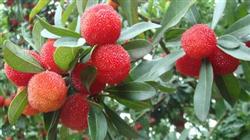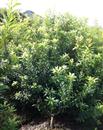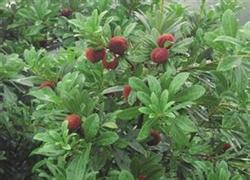Planting techniques of Organic Waxberry (1)

Myrica rubra is the most characteristic subtropical eco-economic tree species with wide adaptability. It can grow and show good characters in most parts of the south, especially in slightly acidic and acidic soils. The organic bayberry orchard is required to be built in acidic yellow soil and red-yellow soil with an altitude of less than 800 meters, a slope of less than 45 degrees, a thick humus layer and a pH value of 4.5-5.5, with shady ventilation and convenient intensive management. convenient for transportation, hills, weak light, deep soil layer. The climatic condition is subtropical humid monsoon climate. Under the microclimate conditions of large light radiation, sufficient heat, high accumulated temperature in winter and spring and moderate low precipitation distribution in summer and autumn, the high quality and high yield are more significant. 2. Planting time: spring planting and autumn planting. Spring planting is from February to early April and autumn planting is from September to November. Spring planting is generally better. Yunnan, Guizhou, Guangxi, Sichuan, Hunan, Jiangxi, Guangdong and Fujian can also be planted from October to late March of the following year. 2. Planting density: the suitable plant spacing is 4m × 4m or 4m × 5m, and 33 ~ 42 plants are planted per mu. The ratio of male to female plants is 100 to 1, but it is not suitable for male plants if there are wild bayberry in the local area. 3. Base fertilizer: planting hole, 80 × 80 × 60cm 3, compost 50kg or barnyard manure 25-30kg or cake manure 3-4kg was applied in each hole, which was covered with 15-20cm thick fertile topsoil. 4. Planting: when planting, place the seedling in the center of the hole, stretch the root system, straighten the seedling, and then add fine soil and beat it with feet or hoes. Pour enough water to fix the root, cover the heart soil at the top to 20-30cm above the ground, and cover the grafting mouth under the soil. After the seedlings are planted, the soil should be loosened, watered and covered with tree plates in time in the high temperature season from July to August, so as to reduce water evaporation. 3. Crown management 1. Shaping (1) Natural happy shape: the first year after planting is dominated by wiping buds, leaving the first main branch from about 20cm off the ground, and then leaving the second or third main branches every 15-20cm; in the second year, the immature autumn shoots are cut off from the extended branches of the main branches, and all the side branches on the main branches are truncated, and the first secondary branch is selected at 60-70cm away from the main branch. In the third year, the second secondary main branch was left on the main branch, and the first and second secondary main branches were alternately 60cm; in the fourth year, the main branch and secondary main branch continued to be extended, and the third secondary main branch was selected at the left and right distance from the second secondary main branch 40cm. While cultivating the main branches and secondary main branches, the large lateral branches should be selected in time, and the plastic surgery should be completed in about 5 years. (2) Natural round head shape: after the seedlings were planted, the seedlings were cut short at about 30-40cm off the ground, and then the other branches were removed as soon as possible except for retaining 3-4 strong branches from the trunk. The retained branches are about 20cm apart from each other and do not overlap each other. The first secondary branch began to be left on the main branch 60-70cm away from the main stem, and then the second secondary branch was left at the 60cm below the other side. Control the overgrowing strong branches outside the main branches and secondary main branches, ease the tree potential, and complete the shaping after 5-6 years. 2. Pruning (1) pruning during the growing period: from mid-April to mid-September. Dormant period pruning: late October to mid-November to mid-February to late March. (2) ① pruning technique: remove useless sprouting from spring to autumn before growth stops, including overgrowing branches at the base of the trunk, overstrong branches on the back of main branches, secondary branches and large auxiliary branches. ② coring: after the shoot begins to grow in spring, the tissue is not lignified. On the one hand, it is to increase the fruit setting rate and reduce fruit drop; on the other hand, it promotes the empty part of the crown to produce secondary branches, and then evolves into fruiting mother branches. ③ pull branch and support branch: generally tie the branch with rope or lead wire in the middle of the backbone branch, pull the branch horizontally according to the angle required by the branch, and the part tied to the branch must be covered with rubber or other soft and tough materials, so as to prevent the bark from being bruised and infected with cancer. The angle between the main branch and the trunk supported by strong short strips of wood. The purpose of the two is to promote the opening of the red bayberry crown, improve the light, uniform results and avoid flat results. ④ ring cutting, ring peeling, upside down peeling, root cutting: ring cutting adopts spiral ring cutting, reaching to the xylem. The width of girdling is controlled at about 1 / 8 of the diameter of the trunk. The width of the inverted skin is controlled at about 1 stroke 4 of the trunk diameter. For the prosperous and long trees with strong growth, low fruit setting rate and low yield, ring cutting, ring peeling, inverted peeling and root cutting can be used. Soil management 1. Soil cultivation is carried out in autumn, winter or spring to reduce topsoil erosion and protect roots. Soil cultivation is generally on the spot, the most commonly used is mountain topsoil, turf mud and so on. 2. Weeding and grass mulching: the growth of young trees is small, and it is easy to be covered by weeds and miscellaneous trees in the mountains, resulting in slow growth and even death. It is required to weed continuously and cover the ground with grass in the range of about 1 meter in diameter of the young tree plate. 3. Expanding holes and improving soil: it is suitable for autumn and winter, it can be carried out in the whole garden at one time, and the holes can be expanded year by year when the tree trunk is insufficient.
- Prev

Four measures to control the growth and growth of bayberry trees
If the bayberry planted on the deep and fertile soil layer is allowed to grow naturally, the vegetative growth will be too prosperous, resulting in most of the nutrients of the tree being consumed by the growth of branches and leaves, resulting in little or difficult formation of flower buds, late fruiting or low yield. Red bayberry tree has the following four measures to control the growing shoot: 1.
- Next

Planting techniques of Organic Waxberry (2)
Fertilization 1, fertilization period, fertilizer application amount: according to the age, growth potential and soil quality of bayberry, take scientific. Formula fertilization. 2. Young trees are mainly "promoting" and pay attention to the application of available fertilizers. The appropriate ratio of nitrogen, phosphorus and potassium is about 0.8 to 0.8, so as to promote shoot growth.
Related
- Moge, come on! The staff of the peasant association in the producing area of cantaloupe were frightened when the crowd gathered.
- Causes and Solutions of low Fruit setting rate of Apple
- Symptoms and control measures of passion fruit virus disease
- Fruit growing lesson: how do apple orchards keep high yields?
- Can you build orchards in the mountains? What are the pros and cons?
- How to manage the coloring period of Crisson grape?
- This paper introduces the processing technology of two kinds of fig products.
- How much is a month for retired teachers in rural areas by 2020?
- How can strawberry planting increase sugar content? We should pay attention to management in many aspects.
- What are the cultivation techniques on how to improve the yield of golden fruit?

